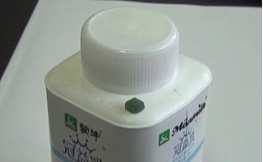 The American Chemical Society (ACS) is pushing for the widespread adoption of new retail packaging design that effectively alerts consumers when their food is going bad and when it's completely spoiled. Using gel tags that are inlaid with nanorods crafted from gold and silver, the packaging detects changing composition of gases and other chemicals within packages. As the composition changes from fresh, edible food toward the spoiled end of the spectrum, the tags change color from red to green to violet — with shades in between — denoting the stages of decay.
The American Chemical Society (ACS) is pushing for the widespread adoption of new retail packaging design that effectively alerts consumers when their food is going bad and when it's completely spoiled. Using gel tags that are inlaid with nanorods crafted from gold and silver, the packaging detects changing composition of gases and other chemicals within packages. As the composition changes from fresh, edible food toward the spoiled end of the spectrum, the tags change color from red to green to violet — with shades in between — denoting the stages of decay.
As the ACS reports, the creative packaging design was pioneered in China, with initial responses to the scientifically fueled designs being overwhelmingly positive. Pushing the creative packaging design into market acceptance, both in the States and abroad, the ACS believes, will have hugely beneficial effects for the consumer and for a food production industry that is increasingly strained to meet global demand.
Why Spoilage-Detecting Packaging is Perfect Product Packaging Design
As a matter of creative packaging design, spoilage-detecting packaging is almost perfect. There are the health benefits to consider, but this packaging fulfills a number of principles of packaging design that could mean increased sales for any company that adopts the science-fiction technology early, including:
Unique, Simple Gimmick Helps Items Stand Out
As Packaging World points out, packaging that grabs customers' attention is crucial to increasing sales through packaging design. A simplistic approach to design has been the key to success in recent history, and this science driven packaging gimmick doesn't violate this rule. In fact, the simplicity of using basic science to provide value to the customer will likely be its saving grace.
Practical Design Helps Consumers Save
Packaging needs to be practical in order for consumers to buy a product. Imagine your favorite hot dog condiment in a jam jar, for example: would ketchup be as useful or convenient of a product if it didn't come in the squirt bottle it's so well known for?
Like the squirt bottle, spoilage-detecting packaging is far more practical than the alternative. MarketWatch.com estimates that Americans throw out half of the food they buy every year, and with it, a lot of money. By telling consumers when they should be using their food, companies using this packaging provide an invaluable service.
This is Sustainable Packaging Design at Its Finest
"Green" and "sustainability" have been buzz words across American industries for the last five years, whether you're talking about electronics or packaging. With the ACS noting that spoilage-detecting technology uses both edible and biodegradable ingredients, like Vitamin C, and with each sensor estimated to cost only $0.002, sensor-tagged packaging is both environmentally and financially friendly.
What do you think about this health savvy packaging promoted by the ACS? Let us know in the comments below.

